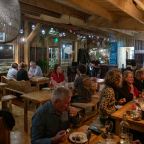
The Box annouces full opening programme
The Box is the largest multi-disciplinary arts and heritage museum space opening anywhere in the UK in 2020. Originally three separate buildings, its ground-breaking design has completely transformed, extended and combined Plymouth’s former City Museum and Art Gallery, Central Library buildings and St Luke’s Church to create a cutting-edge, interactive cultural centre with 13 new galleries and exhibition spaces, a striking elevated archive, learning and research facilities, and the first public square to be built in Plymouth since 2004.
The Box will open on May 16 2020 with 12 new exhibitions showcasing contemporary art alongside Plymouth’s rich heritage, ambitious touring exhibitions alongside the city’s permanent collections, natural history alongside maritime history, interactive exhibits, giant art installations, immersive film and photography exhibits, as well as activities for children.
Tudor Evans, Leader of Plymouth City Council, said: At the heart of The Box’s ethos is the conservation, heritage and preservation of Plymouth’s rich history and heritage. Once completed, it will bring together six outstanding national collections in a new and sustainable home, including objects from Plymouth City Museum and Art Gallery, archives from the Plymouth and West Devon Record Office and film, and photographs from the South West Film and Television Archive and the South West Image Bank. This rich blend of collections will enable the stories of international and local significance to be told through immersive experiences and amazing objects.
Nicola Moyle, Head of Heritage, Art & Film at The Box, said: The Box, which will open in spring 2020 as part of Plymouth’s major Mayflower 400 commemorations, will also be renowned for its engaging and highly immersive exhibition programme. The programme will integrate the contemporary and the historic to bring the past to life through the present. It will showcase international visual arts and media, as well as Plymouth’s rich heritage through ambitious touring exhibitions, new commissions and the city’s permanent collections.
Nigel Hurst, Head of Contemporary Art at The Box, said: We are thrilled to be launching The Box’s opening contemporary art exhibitions, which are part of the new museum’s unique programme that gives internationally acclaimed contemporary artists the opportunity to respond to The Box’s collection and Plymouth’s social history. One of our opening exhibitions, Making It brings together internationally recognised artists, whose works that provide contrast between the labour-intensive and wrought process of craft, fabrication, manufacture and making object and installations with material integrity with our and the contemporary culture of instant gratification in the age of social media. Polyphony presents a selection of important acquisitions to The Box’s permanent collection, telling new stories about present-day issues of identity and memory.
OPENING EXHIBITIONS
The three major exhibitions in the opening programme are:
·Mayflower 400: Legend and Legacy will be the largest commemorative Mayflower exhibition in history with over 300 objects. Co-curated with the Wampanoag Native American Advisory Committee, it will turn history on its head.
·Making It: International contemporary art exhibition featuring newly commissioned works by Antony Gormley, Portuguese artist Leonor Antunes and Brazilian artist Alexandre da Cunha.
·Polyphony: An exhibition newly acquired work for The Box’s contemporary art collection, featuring a three-channel film work by Kehinde Wiley – the first digital work by this internationally renowned painter.
MAYFLOWER 400: LEGEND AND LEGACY
16 MAY 2020 – SEPTEMBER 2021
FREE FOR RESIDENTS OF PLYMOUTH & UNDER 18S | TICKETED £5 ENTRY FOR NON-RESIDENTS |
Mayflower 400: Legend and Legacy is the national commemorative exhibition for the Mayflower 400 anniversary and the largest loans exhibition ever staged by the city of Plymouth.
Co-curated with the Wampanoag Native American Advisory Committee, in a landmark move, the Wampanoag have contributed directly to an exhibition exploring the history of the Mayflower. Forget everything you thought you knew already - this is the first exhibition to tell the true story of the Mayflower, the enduring myths it has created and its lasting legacy.
Mayflower 400: Legend and Legacy acknowledges conflict with the Native American’s and the impact of settlers on the indigenous population using objects, images and ideas to explore early English attempts to colonise America. It discusses the context of the sailing of the Mayflower in 1620, detailing the lives of the passengers and those of the Wampanoag, as well as considering the cultural, demographic and personal legacies of the story from both sides of the Atlantic.
It includes the first Bible to be printed in America, the last known record of the Mayflower, and the first Wampanoag art commissioned by the city. 400 years on, this is an iconic moment in global history, from which 30 million people can trace their ancestry and claim a connection to theMayflower, as well as the 102 passengers who defined our relationship with America.
The 300 items, on loan from 100 museums, libraries and archives from around the world, include Native American items from The National Museum of the American Indian and the Harvard Peabody collection, as well as the Second Pierce Patent from Pilgrim Hall Museum, the oldest existing state document of New England. Central to the exhibition will be a new Wampanoag piece, created specifically for this show by the artist Nosapocket / Ramona Peters. Her artwork is Plymouth’s first ever artistic commission to a Wampanoag artist, and The Box is honoured to welcome it into its permanent collections.
The exhibition also includes fishing weights and arrowheads that have endured over time, showing the longevity of the Wampanoag – the People of the First Light who have lived in the American eastern woodlands for 12,000 years. A wooden ladle, an eel trap and a bow will highlight the early contact period. A John Eliot Bible (the first complete Bible to be published in America and the first in the language of the Wampanoag people) will be shown alongside historic photographs from the Mashpee Government. 17th century children’s toys will remind visitors of the passengers, who included 19 families, unaccompanied children and two dogs.
MAKING IT
16 MAY – 31 AUGUST 2020
Making It will be the inaugural contemporary art exhibition at The Box. The show aims to contrast the labour intensive and wrought nature of making and fabricating artworks of material integrity, referencing Plymouth’s history as a city of makers and crafts people, with instant success gratification, 15 minutes of fame and wannabe culture in our age of social media. The exhibition will include works by five leading international contemporary artists: Leonor Antunes, Christopher Baker, Alexandre Da Cunha, Antony Gormley and Eva Grubinger.
Two of the artists have been commissioned to make works in the public realm that will become part of The Box’s permanent collection. Antony Gormley has been commissioned to make a new public sculpture on Plymouth Hoe, which also forms part of the Mayflower 400 commemorations. Leonor Antunes has been commissioned to make a new permanent fused glass window for St Luke’s.
POLYPHONY
16 MAY – 31 AUGUST 2020
When Plymouth City Museum and Art Gallery closed its doors in 2016, the art collection it held was 99% the work of white, male and European artists. Now incorporated into The Box, the same collection is being extended and developed by the acquisition of artworks, which explore a range of media and are made by artists of diverse backgrounds. The Box is building a collection of many voices – a polyphony.
In this exhibition, The Box presents a selection of important new acquisitions to its collection, starting with the three-channel video Narrenschiff by American artist Kehinde Wiley, which was acquired through the Contemporary Art Society’s Collections Fund at Frieze 2018, alongside two works byZadie Xa. Other featured artists include Charlotte Moth, Suzanne Triester and Laura Eldret.
Narrenschiff (Ship of Fools), the debut film by acclaimed American artist Kehinde Wiley, will be shown in The Levinsky Gallery, situated in The Arts Institute at the University of Plymouth. Wiley’s exquisite first video work depicts an allegorical seascape that evokes a sense of migration and yearning for liberation.
PERMANENT DISPLAYS
At the heart of The Box’s ethos is the conservation and preservation of Plymouth’s rich history and heritage. The Box brings together six outstanding collections in a new and sustainable home, including objects from Plymouth City Museum and Art Gallery, archives from the Plymouth and West Devon Record Office, film and photographs from the South West Film and Television Archive and South West Image Bank, furniture, texts, Old Master drawings and art from theCottonian Collection, and incredible animal specimens from the Plymouth Natural History Collection. This rich blend of collections will enable stories of international and local significance to be told through immersive experiences and amazing objects.
The Box is moving 2,177,516 objects into the building before it opens on May 16 2020. The heaviest is a 2 ½ tonne ship’s figurehead, King Billy. The smallest is a feather-winged beetle, the size of a full stop. The Box’s collections tell the stories of a nation and include the UK’s most significant collection of explorer materials, the Plymouth Bomb Book, evidencing the most destructive raids of WW2 and proof that Devon invented the Cornish pasty. The Box also holds the UK’s largest regional film and television archive (250,000 individual films), while the newest addition to its collections will be a full-scale replica of a female mammoth that has been made in Minnesota.
Nine permanent galleries will showcase The Box’s incredible collections, they include:
·Figureheads: A magnificent display of 14 monumental ships’ figureheads, collectively weighing over 20 tonnes
·100 Journeys: Great explorers and their discoveries, from Drake to Scott and beyond
·Mammoth: Plymouth’s incredible natural history collections featuring a 1,000 pickled marine creatures and a full-size mammoth replica
·Our Art: From Reynolds to Lenkiewicz: a show case of Plymouth’s art collection
·Port Of Plymouth: A celebration of Plymouth’s naval and maritime past
·Media Lab: Interactive room featuring the UK’s largest regional film and television archive
·Cottonian Collection: Illuminated manuscripts, Old Master drawings and fine art
·Active Archive: Public access to The Box’s huge archive containing some of the city’s most fascinating documents
·Photo Album: A showcase of objects, memories and photographs from Plymouth’s past
FIGUREHEADS
The Box has saved 14 monumental 19th century naval figureheads from decay for the nation, in the most ambitious sculpture conservation project to have taken place in the UK over the last couple of years.
Weighing over 20 tonnes collectively, the 14 figureheads will welcome visitors to The Box in an ambitious aerial display, which will see each figurehead suspended within the main glass atrium in a huge sweep that appears to sail across the glazed façade of the new entrance.
The largest of the 14 wooden figureheads to be rescued is HMS Royal William or ‘King Billy’, a 13ft tall, 2 tonne standing figure of William IV carved in 1833. One of the most badly damaged of the figureheads was HMS Topaz, a three-quarter-length female bust carved in 1858, whose ship was responsible for removing two of the Easter Island statues that are now in the British Museum’s collection. Topaz had wood rot throughout 90% of her structure, but conservators used extraordinary techniques including sonic tomography to save her carved outer shell, before carefully replacing the rotting wood and repainting her.
The ambitious aerial display concept has compelled teams of conservators to create complex but elegant structural mounts, with each figurehead secured in place with only 3 cables, creating the effect of a fleet of carvings floating in space. A mass display of ships’ caps and badges runs the full height of one wall in the atrium, forming a backdrop to the flotilla.
The figureheads will be unveiled on 14 April where they will be visible through the glass front of The Box, ahead of the grand opening on 16 May.
100 JOURNEYS
100 Journeys explores some of the momentous and notorious voyages that began in Plymouth and went on to change the world. The gallery features breath-taking original artefacts from voyages of exploration and scientific discovery, including Sir Francis Drake, Sir Walter Raleigh, Captain James Cook, Charles Darwin, Gertrude Benham and Scott of the Antarctic.
The Box holds the UK’s most significant collection of explorer materials, which will all be on display, including Sir Francis Drake’s sword, globe and drum, Scott of the Antarctic’s skis and mittens and Darwin’s sextant from the Beagle, as well as letters written by Raleigh and archival material from Plymouth’s anti-slavery movement. Key objects from The Box’s two million strong collection of artefacts also highlight the missionary Harry Moore Dauncey’s Papua New Guinean collection, Nigerian spoils of war brought back by Lieutenant Francis Pye, and an Egyptian mummy sarcophagus brought back from one of the many journeys to Egypt, where Ancient Egyptian excavations were being carried out in the 19th century.
The centrepiece of the gallery is a stunning animated globe highlighting key journeys. Interactive touchscreens let you explore dozens more surprising journeys that began in Plymouth, from Sir Francis Chichester, the first person, and fastest circumnavigator, to sail around the world alone by the clipper route in 1967, to climate activist Greta Thunberg, whose carbon neutral transatlantic crossing to America recently started from Plymouth aboard a racing yacht.
MAMMOTH
The Box is home to Plymouth’s Natural History Collection, one of the most important collections in the UK that contains 150,000 natural history specimens. In 1884, the Marine Biology Association was set up in Plymouth and the city remains a world leader in marine research.
The collection includes the largest archive of human remains from a single prehistoric site in Europe, Cattedown. Highlights include a 35,000 year old cave lion skeleton (the only one on display in the UK), the oldest coat in Europe (a Bronze age bear pelt), an estimated 90,000 insects, including five species of bug only found in Devon (Horrid Ground Weaver and Hedgehog Harvestman, anyone?), 10,000 minerals, 10,000 plants and one of the UK’s largest collections of wet-preserved marine specimens stored in formaldehyde in 6,000 jars.
At the centre of the gallery surrounded by butterflies, taxidermy, birds’ eggs and other species, stands a life-size woolly mammoth, bursting out of the collection. The Box’s collection of fossils shows that around 30,000 years ago, during the ice age, Mammoths were very common in Plymouth. The Box’s mammoth was constructed based on information researchers found from studying a mammoth tooth in The Box’s collections. The tooth will also be on display.
A significant display of 1,000 preserved marine animals in jars, known as ‘pickles’ and weighing over 5 tones collectively, will showcase Plymouth’s marine life.
Challenging the traditional approach to natural history museums, visitors can step into some of the cases to be surrounded by the insects and butterflies, while rocks and minerals are mounted to give a sense of movement as they burst out of their displays
Bringing things right up to date, this gallery also looks at climate change and the impact humans have on the ocean and marine wildlife
PORT OF PLYMOUTH
Port of Plymouth explores the symbiotic journey Plymouth has with the sea: from the city’s origins as Bronze Age settlements through to its growth into a powerhouse of trade and commerce, and its final expansion to become an epicentre of both maritime industry and defence. Visitors will find themselves immersed in collections of archaeology, oil paintings, ship models and social history through film, animation and sound – bringing this epic and historic relationship to life.
Stand before Britain’s only surviving Early Bronze Age bear pelt, thousands of years of history captured in the Elburton Urns, or treasures like the Dunterton gold and sapphire ring. Picture yourself among the teeming crowds in Plymouth Sound, as they witnessed a defeated Napoleon awaiting his fate. Find out how Devonport Dockyard progressed from building sailing ships to nuclear submarines through five centuries of industry and innovation.
Discover the stories behind the objects through the communities that shaped the port and our wider city. The Whitehorse Hill settlers who first called Devon their home, the ‘yardees’ that tramped through our dockyard gates daily, fishermen who battle the elements to land a catch, troops that go off to war, and the families they leave behind.
OUR ART
The Box owns one of the largest museum collections of fine art in the UK and Our Art showcases four centuries of artistic talent from the South West. This includes paintings by Joshua Reynolds, who set up his first studio in Plymouth, before going on to found the Royal Academy of Art and become one of the most important portrait painters of the eighteenth century. In addition, Salon will feature works by Stanhope Forbes and Barbara Hepworth, who were drawn to the South West by the luminous quality of coastal light and were key figures in the Newlyn and St Ives artist colonies.
Salon will also exhibit part of The Box’s significant decorative arts collection in a mass display of over 350 objects, including ceramic, glass, silver, silk, wool, wooden objects and selected items from the largest collection of Plymouth porcelain in the UK. The exhibition tells the story of William Cookworthy, the first person in the UK to discover the formula for true (hard-paste) porcelain. Credited with the invention of British porcelain, he founded the Plymouth Porcelain Factory.
A grand display of paintings that represent over 400 years of artists painting Plymouth’s unique landscape will take up one wall of the gallery. The paintings follow the City’s coastline from the River Plym to the River Tamar and provide a varied vista of Plymouth through the eyes of artists across the centuries. They include small sketches and watercolours that date from the 1600s and which represent some of the earliest existing depictions of Plymouth.
MEDIA LAB
Media Lab is a showcase for the South West Film and Television Archive (SWFTA), one of the richest regional film archives in the UK that holds thousands of reels of film footage, dating back to the late Victorian era. Families and kids visiting the Media Lab will have the opportunity to present a TV programme, edit a film, gain access to 1,000s of images and films from the collection, and even get a chance to meet famous South West puppet Gus Honeybun.
Media Lab includes a mock TV studio, developed in partnership with BBC South West, offering visitors the chance to present the news and select from clips that draw on material from the BBC News Archive. Classic ‘I remember when’ moments will appear on a retro display of television sets featuring clips from the collections. A huge Big Screen covers three walls of the gallery and shows moving image material ranging from silent black and white film, evocative images of wartime and reconstruction, to The Beatles visiting Plymouth.
In total, Media Lab will showcase over 1,000 images and film clips, and over 300 objects includingGus Honeybun, the beloved mascot of Westward and Television South West (TSW), seated alongside some fascinating examples of film and tape editing equipment. Film footage will include the earliest film captured in the South West of England in 1898, as well as the earliest colour film from 1939. There will also be incredibly rare images of the city from the 1850s onwards on display.
Media Lab also highlights the South West Image Bank. Made up of 170 individual collections and close to one million negatives dating back to the 1870s, it’s one of the largest bodies of photographic records in the country. Most of the collections are in original format, ranging from glass plate to transparency negatives and slides. Included are images depicting the immediate post-war development of the city and the Western Morning News Archive, with some two million images relating to civic events, transport, people, places and culture.
COTTONIAN COLLECTION AND RESEARCH ROOM
“One of the most important collections in the UK” Anthony Griffiths, Keeper of Prints and Drawings at the British Museum until 2011
The outstanding Cottonian Collection is an internationally important 18th century collection of paintings, Old Master drawings, books, prints, ceramics, furniture, bronzes and sculpture assembled by five men over 200 years, led by Charles Rogers. Rogers also designed the beautiful furniture in which the collection is stored. The collection was inherited from and left to Plymouth by William Cotton III, for the “use of the inhabitants of Plymouth, Stonehouse and Devonport, for their amusement and instruction”.
The Cottonian Collection consists of 2,000 volumes, 100 Old Master drawings, 3,000 of the finest prints from England and Western Europe made between the 16th and 19th centuries, examples of Dutch landscapes, Italian religious paintings, sculpture, furniture and a particularly important group of family portraits by Sir Joshua Reynolds. Other key objects include a stunning ‘Book of Hours’ from the 1400s, Durer’s ‘Passion of Christ’, a ‘Sitter’s Book’ belonging to Joshua Reynolds (listing all those who sat for him in 1755) and four Reynolds’ portraits.
In addition to displaying the historic Cottonian Collection, Cottonian Research Room is a place where The Box’s collections can be accessed. Whether tracing their family history, working on a school project or researching a PhD thesis, members of the public are able to access all of the collections free of charge by appointment only.
PHOTO ALBUM
Photo Album will showcase thought-provoking photographic displays that reflect the lives of people in Plymouth and its diverse communities. The gallery is split into two sections, a photo wall and an area highlighting community participation through projects and co-curation.
On the photo wall Plymouth: The Five Towns presents a selection of images showing the city from the late nineteenth century to the present day. Visitors will be able to recall familiar buildings from the area, revisit family, friends and the way people once lived and see how the city has changed over the years.
In the community display section visitors can find out more about a major community project supported by The Box which has reached over 250,000 people. Maker Memories has been collecting stories and memories to help preserve the social history of Maker Camp on the Rame Peninsula in Cornwall during the last couple of years. Originally a military base, Maker Camp has hosted summer camps, festivals and weddings. Now a popular campsite, it holds a special place in the hearts and minds of thousands of people from Plymouth and beyond. This project has already engaged with more than 16,000 people through a series of events and displays and has reached nearly 250,000 people online.
ACTIVE ARCHIVE
Active Archive illustrates key episodes in the history of Plymouth, using archive documents, books, historic artefacts, interactive displays and photographs. For example, The Box’s archive holds proof that Devon invented the Cornish pasty – the earliest record of a pasty recipe, dating from 1510. The Active Archive also contains some of the city’s most amazing documents, including the Bomb Book, which records the location of every high-explosive bomb dropped on the city.
Visitors can enter the gallery through an Elizabethan doorway and transport themselves into an influential seafaring community of the sixteenth century, coming face to face with Queen Mary through Plymouth’s oldest original and illuminated charter, dated 1554. Visitor can learn more about the history of the Elizabethan House still in existence on one of Plymouth’s oldest streets.
From more recent times, they can find out how the city was destroyed in the Second World War and rebuilt to a radical new plan, and stop to imagine what life was like for Plymothians during the war through objects such as a baby’s gasmask and an incendiary bomb. Residents can find out if their house or street was damaged or destroyed during the war by using the interactive Bomb Book, which records the location of every high-explosive bomb dropped on the city.
Active Archive also includes the Plymouth Local Studies Library Collection with 35,000 volumes and major country periodicals, such as Devon Life and The Local Historian, the Baring-Gould collection of manuscripts of local folk-songs, newspapers dating back to 1721, maps going back to 1643 and old theatre posters.













